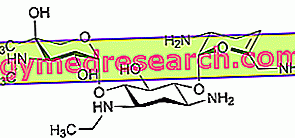Netilmicin is an antibiotic belonging to the class of aminoglycosides.
It is available for ocular and parenteral administration.

Netilmicina - Chemical Structure
Indications
For what it uses
The use of netilmicina is indicated for the treatment of:
- External eye and appendage infections caused by micro-organisms sensitive to netilmicin itself (ocular administration);
- Pleuro-pulmonary infections (parenteral administration);
- Infections of the kidneys and urinary tract (parenteral administration);
- Surgical infections (parenteral administration);
- Gynecological infections (parenteral administration);
- Gastrointestinal and biliary tract infections (parenteral administration);
- Septic states (parenteral administration).
Warnings
Prolonged use of netilmicin administered via the eye can cause sensitization, if this happens, treatment with the drug should be stopped and the doctor should be consulted.
Due to the possible onset of nephrotoxicity and / or ototoxicity (respectively toxicity of the kidneys and hearing), patients receiving netilmicin should undergo regular checks of renal, auditory and vestibular function.
When netilmicin is administered parenterally, its blood concentration should be regularly monitored, in order to avoid the achievement of high levels of potentially toxic antibiotic.
Patients must be well hydrated during parenteral netilmicin treatment.
Caution should be exercised in the administration of netilmicin in patients with myasthenia gravis, Parkinson's disease or infant botulism, as the antibiotic may aggravate the muscle weakness caused by these diseases.
Interactions
The concomitant use of other nephrotoxic or ototoxic drugs should be avoided during netilmicin treatment. Among these drugs, we recall:
- Polymyxin B or colistin, other antibiotic drugs;
- Kanamycin, gentamicin, amikacin, neomycin, tobramycin, streptomycin or paromomycin, other aminoglycosides;
- Cisplatin and other platinum compounds used in cancer therapy;
- Amphotericin B, an antifungal;
- Ciclosporin or tacrolimus, immunosuppressive drugs used in the prevention of transplant rejections;
- Powerful diuretics, such as etacrinic acid, furosemide or mannitol .
In any case, it is still necessary to inform your doctor if you are taking - or have recently been taken - drugs of any kind, including over-the-counter medicines and herbal and / or homeopathic products.
Side effects
Netilmicin can cause various types of side effects, although not all patients experience them. The type of adverse effects and the intensity with which they occur depend on the sensitivity that each individual has towards the drug.
The following are the main side effects that may occur during treatment with netilmicin.
Kidney and urinary tract disorders
Netilmicin therapy may cause:
- Presence of filaments, proteins or cells in the urine;
- Increase in urea and non-protein nitrogen in the bloodstream;
- Increased serum creatinine;
- Oliguria.
Ear and labyrinth disorders
Treatment with netilmicin may cause:
- Instability;
- Dizziness;
- Tinnitus;
- Hearing loss in high tones.
Skin and subcutaneous tissue disorders
Netilmicin-based therapy may cause:
- Skin eruptions;
- Rash;
- Itch.
Gastrointestinal disorders
Treatment with netilmicin can cause vomiting, abdominal pain, diarrhea and stomatitis.
Blood and lymphatic system disorders
Netilmicin therapy may cause:
- Increased number of platelets in the bloodstream;
- Eosinophilia, ie the increase in plasma concentration of eosinophils;
- Anemia;
- Plateletopenia (ie decrease in the number of platelets in the bloodstream), with consequent increased risk of bleeding;
- Leukopenia, ie the reduction in the number of leukocytes in the bloodstream.
Nervous system disorders
Treatment with netilmicin may cause:
- Headache;
- paresthesia;
- Disorientation;
- Confusion;
- Depression.
Hepatobiliary disorders
Netilmicin therapy can cause liver function abnormalities, increased transaminase blood levels, alkaline phosphatase levels, sometimes accompanied by mild hepatomegaly and increased bilirubin blood levels.
Other side effects
Other side effects that may occur during netilmicin therapy are:
- Allergic reactions in sensitive subjects;
- Temperature;
- Malaise;
- Cooling pathology;
- Anorexia;
- Fluid retention;
- Increased blood concentrations of potassium;
- Visual disturbances;
- Hypersalivation.
Side effects typical of ocular administration
When administered via the eye - in the form of eye drops or ointment - netilmicin may cause temporary eye irritation or hypersensitivity reactions characterized by conjunctival redness, burning or itching.
Overdose
In the case of overdose with parenterally administered netilmicin, hemodialysis may be useful to remove the drug from the plasma. In newborns blood transfusions can be performed.
If you suspect overdosage, you must inform your doctor immediately.
Action mechanism
Netilmicin is an aminoglycoside and, as such, carries out its antibiotic action by interfering with the protein synthesis of bacteria.
Protein synthesis in bacterial cells takes place thanks to organelles called ribosomes. These organelles consist of ribosomal RNA and proteins associated with each other to form two subunits: the 30S subunit and the 50S subunit.
The task of the ribosome is to translate the messenger RNA from the cell nucleus and to synthesize the proteins for which it encodes.
Netilmicin binds to the 30S ribosomal subunit and, in doing so, prevents messenger RNA from binding to the ribosome and, furthermore, induces a "misreading" of the same messenger RNA, forcing the ribosome to synthesize "wrong" proteins called non-proteins sense.
Some of these nonsense proteins enter the bacterial cell membrane and alter its permeability. The alteration of the permeability of the membrane allows the entry of further antibiotic into the cell, causing a total block of protein synthesis.
Mode of Use - Posology
Netilmicin is available for ocular administration as eye drops and ophthalmic ointment and for intramuscular or intravenous administration as a solution for injection.
Intramuscular or intravenous administration
In adults, the dose of netilmicin usually administered is 4-6 mg / kg of body weight per day, to be divided into several administrations.
In children, the netilmicin dose usually used is 6-7.5 mg / kg of body weight per day, to be taken in more divided doses.
In infants over one week of age, the netilmicin dose usually used is 7.5-9 mg / kg of body weight per day, to be taken in divided doses.
In premature and infants with less than one week of life, the netilmicin dose usually administered is 6 mg / kg of body weight per day, to be administered in two divided doses.
Patients with renal failure will receive a lower netilmicin dose than is usually used.
Ocular administration
When using eye drops, it is recommended that one or two drops of the drug be instilled into the conjunctival sac three times a day or as prescribed by the doctor.
When using the ophthalmic ointment, this should be applied 3-4 times a day.
If eye drops have been prescribed together with the ointment, then a single evening application is sufficient.
Pregnancy and breastfeeding
Netilmicin can cross the placenta and cause fetal harm. Cases of irreversible bilateral congenital deafness have been reported in newborns whose mothers took the drug during pregnancy.
Therefore, before taking the drug, pregnant women should be informed of the possible risks to the fetus. In any case, the antibiotic should only be used if the doctor considers it absolutely essential for the expectant mother.
Netilmicin is excreted in breast milk and can cause harm to the baby, therefore, generally, the use of the drug by breastfeeding mothers is not recommended.
Contraindications
The use of netilmicin is contraindicated in the following cases:
- In patients with hypersensitivity known to netilmicin;
- In patients with known hypersensitivity to other aminoglycosides.



